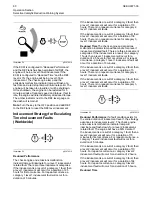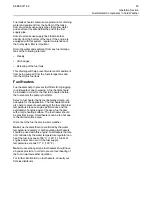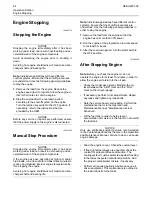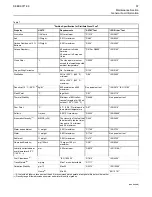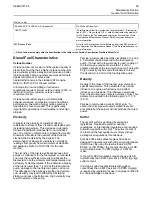
Cold Weather Operation
i07622821
Radiator
Restrictions
Perkins
discourages
the
use
of
airflow
restriction
devices
that
are
mounted
in
front
of
radiators.
Airflow
restriction
can
cause
the
following
conditions:
• High exhaust temperatures
• Power loss
• Excessive fan usage
• Reduction in fuel economy
Reducing air flow over components will also affect
under hood temperatures. Reducing air flow can
increase surface temperatures during an
aftertreatment regeneration and could affect
component reliability.
If an airflow restriction device must be used, the
device should have a permanent opening directly in
line with the fan hub. The device must have a
minimum opening dimension of at least 770 cm
2
(120 in
2
).
A centered opening that is directly in line with the fan
hub is specified to prevent an interrupted airflow on
the fan blades. Interrupted airflow on the fan blades
could cause a fan failure.
Perkins recommends a warning device for the inlet
manifold temperature and/or the installation of an
inlet air temperature gauge. The warning device for
the inlet manifold temperature should be set at 75 °C
(167 °F). The inlet manifold air temperature should
not exceed 75 °C (167 °F). Temperatures that
exceed this limit can cause power loss and potential
engine damage.
i07818744
Fuel
and
the
Effect
from
Cold
Weather
Note:
Only
use
grades
of
fuel
that
are
recommended
by
Perkins.
Refer
to
this
Operation
and
Maintenance
Manual,
“Fluid
Recommendations”.
Properties
of
the
diesel
fuel
can
have
a
significant
effect
on
the
engine
cold
start
capability.
It
is
critical
that
the
low
temperature
properties
of
diesel
fuel
are
acceptable
for
the
minimum
ambient
temperature
the
engine
is
expected
to
see
in
operation.
Following
properties
are
used
to
define
fuels
low
temperature
capability:
• Cloud point
• Pour point
• Cold Filter Plugging Point (CFPP)
The cloud point of the fuel is the temperature at
which waxes naturally found in the diesel fuel begin
to form crystals. The cloud point of the fuel must be
below lowest ambient temperature to prevent filters
from plugging.
Pour point is the last temperature before the fuel flow
stops and waxing of the fuel will start.
Cold Filter Plugging Point (CFPP) is a temperature at
which a particular fuel will pass through a
standardized filtration device. This CFPP gives an
estimate of the lower operability temperature of fuel
Be aware of these properties when diesel fuel is
purchased. Consider the average ambient air
temperature for the engines application. Engines that
are fueled in one climate may not operate well if the
engines are shipped to colder climate. Problems can
result due to changes in temperature.
Before troubleshooting for low power or for poor
performance in the winter, check the fuel for waxing
The following components can provide a means of
minimizing fuel waxing problems in cold weather:
• Fuel heaters, which may be an OEM option
• Fuel line insulation, which may be an OEM option
Winter and arctic grades of diesel fuel are available in
the countries and territories with severe winters. For
more information refer to the Operation and
Maintenance Manual, “Fuel For Cold-Weather
Operation”
Another important fuel property which can affect cold
start and operation of diesel engine is Cetane
number. Detail and requirements of this property are
given in this Operation and Maintenance Manual,
“Fluid Recommendations”.
i06093465
Fuel
Related
Components
in
Cold
Weather
Fuel
Tanks
Condensation
can
form
in
partially
filled
fuel
tanks.
Top
off
the
fuel
tanks
after
operating
the
engine.
62
SEBU9071-06
Содержание 2206F-E13TA
Страница 126: ......
Страница 128: ...SEBU9071 2020 Perkins Engines Company Limited All Rights Reserved 128 December 2020 ...













